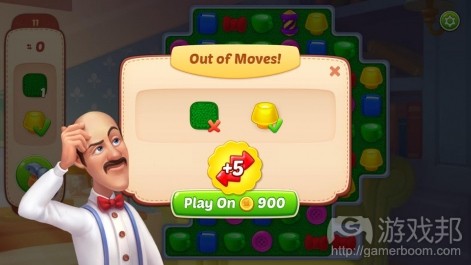从产品测试角度聊《梦幻家园Homescapes》是如何盈利的
原文作者:Matt Suckley 译者:Megan Shieh
欢迎回到In-App Purchase Inspector,在这里我们会以消费者的视角,定期测评一些F2P游戏。
每期文章,我们都会考虑游戏中IAP的诱因、压力、它们的感知价值、IAP带来的扩展内容还有整个游戏体验的评估。
最终目的就是看看这游戏究竟值不值得我们砸钱,不花钱的游戏体验是否也能让玩家感到满足。
《梦幻家园(Homescape)》是Playrix出品的热门三消手游《梦幻花园(Gardenscapes)》的续作,本作延续了前作的模拟经营特性,以室内设计为主题。
欢迎回家
尽管俄罗斯工作室Playrix此前也推出过一些成功的作品,但真正让手游世界认识到他们的是2016年的《梦幻花园》。
《梦幻花园》是一款将三消玩法、叙事以及少量花园设计元素结合到一起的大型模拟经营类手游。
这种结合使得它在千篇一律的三消游戏市场中脱颖而出,而该作的收入排名也说明了玩家的态度。
Playrix明显尝到了甜头,因此随后以同样的配方开发了《梦幻家园》,游戏中的主人公还是那个叫做奥斯汀的管家,游戏主题从园艺变成了家装。
三消设计
某天夜里,奥斯汀回忆起爷爷一手修建的大房子,怀念童年的点滴美好,感慨万千,第二天就拉着玩家回家探望了,谁知道,原本记忆中的美好家园早已被岁月洗礼,变得残破不堪,大部分家具年久失修已经面临报废的危机,而且还发现奥斯汀的父母计划把房子卖了,搬到别的地方去住。
玩家的任务就是协助奥斯汀把房子变得焕然一新,以此来改变他父母卖房子的想法。像更换椅子或是铺地毯这类的任务都会被添加到待办事项列表中,有点像资源管理类体裁。
但是玩家不用出去购买这些材料;而是通过闯关获得行动点,用行动点来完成任务。
每完成一个关卡后会产生一颗星星,然后玩家需要用这些星星来完成任务。任务完成后,玩家可以根据自己的喜好,选择三种设计方案中的一种。
这种做法允许玩家慢慢地调整房子的设计,并给予玩家额外的视觉回报来奖励每一个完成的任务。
边玩边进步
与《梦幻花园》的设计一样,玩家不能通过IAP购得星星,唯一的获得方式就是完成关卡。
游戏中的唯一一种货币是‘金币’。金币可以通过闯关获得,数量取决于玩家在关卡中的表现;其次,玩家也可以用真钱来购买金币。
成捆金币的价格从0.99美元(1000枚金币)到99.99美元(150000枚金币)不等。它最重要的用途是购买生命(体力值),与《Candy Crush Saga》的系统相似,闯关的时候,每失败一次就会失去一条命,生命的上限为5,每25分钟会自动补充一条命。一条命值900枚金币,实际货币约为0.90美元。
金币的另一个主要用途是购买强化道具——使闯关的过程变得更加容易。
自给自足
但这种削减式的手法也存在缺陷。例如,因为游戏中只有一种货币,所以玩家可能很快就会发现自己卡在某个关卡,无法继续玩下去。
有时候遇到了相当棘手的关卡,我发现自己只有898枚金币,差2枚金币就可以买一条命或额外的5步;但是不想花真钱的我就只能傻傻地等25分钟…
此外,除非你成功闯关,不然根本就没办法获得更多的金币。没有足够的金币也意味着你不能购买任何强化道具,或者在步数用完的时候继续玩下去。
有些游戏会使用奖励视频广告来帮助玩家摆脱这样的困境,但在《梦幻家园》里,你的选择除了傻等就是花真钱。
当然这并不一定是坏事,因为这是F2P游戏最基本的原则;但它同时也表明了一点——简单粗暴并不一定就代表玩家会喜欢。
在花真钱这件事上,挫折似乎是不可避免的强大驱动因素。
总结
《梦幻花园》的例子告诉我们手游热门不必全盘重来——《梦幻家园》以既可靠又准确的盈利技巧延续了前作的玩法。
游戏中的故事并非扣人心弦,但却很有魅力,以一种温和的速度向前,但却让玩家感到出奇地愉快。
闯关成功时,玩家得到的不仅仅是进步的感觉,还有帮奥斯汀修复了一部分家园的小小满足感。
以叙事作为盈利机制的吸引点,这可能是我们能从《梦幻家园》和《梦幻花园》中学到的最有意思的东西。
结论:《梦幻家园》以一种简单有效的方式驱动玩家花钱,但是不花钱的玩家可能偶尔会觉得这游戏有点不耐玩。
本文由游戏邦编译,转载请注明来源,或咨询微信zhengjintiao
Welcome back to the In-App Purchase Inspector - our regular look at free-to-play games from the consumer’s perspective.
In each instalment, we consider the incentives or pressure applied to make in-app purchases, their perceived value, the expansion offered by IAPs and the overall value of the experience.
The end goal is to see whether the game makes a good enough case for us to part with our cash, or whether players are content – or engaged enough – to ‘freeload’.
This time we’re taking a look at Homescapes, the interior design-themed follow-up to Playrix’s breakout mobile hit Gardenscapes.
Welcome home
Despite Russian studio Playrix having launched some successful games previously, it was 2016′s Gardenscapes that made the mobile gaming world really stand up and take notice.
Gardenscapes, which was for much of its development a hidden object title, combines match-three gameplay with an ongoing narrative and some very light garden design elements.
This makes it distinct in a genre in which new ideas are rare, and the game’s grossing ranks show that players were receptive to such a combination.
Understandably keen not to lose that magic,Homescapes is very much a continuation of the same formula, with protagonist Austin the butler swapping gardening for home renovation.
Matching designs
The game begins with Austin returning to his family home, where he is shocked to learn that his parents intend to sell up and move elsewhere.
The player’s role, then, is to help him spruce up the place in an effort to change their minds. Jobs to this end – like replacing a chair or laying a carpet – are added to a to-do list, in a manner more familiar to the resource management genre.
But instead of having to go out and buy the resources to fulfil these demands, here tasks are tackled by completing match-three stages.
Each level completed yields a Star, which is then used to complete a task. When a task is completed, the player gets to choose which of three designs they prefer.
This allows the player to slowly tailor the home’s design, and gives an extra visual pay-off to reward each completed task.
Play to progress
But like in Gardenscapes, Stars aren’t available through in-app purchases; they can only be earned by completing levels.
Instead, things are streamlined with a single currency: Coins. These are also earned by completing levels – you get more depending on how well you perform in each – but can also be bought using real money.
Coins come in bundles ranging from $0.99 for 1,000 to $99.99 for 150,000. Their most important use is probably to buy Lives which, in a system familiar to Candy Crush Saga players, deplete with each failure in a level, are capped at five and regenerate at a rate of one per 25 minutes.
One Life costs 900 Coins, which is around $0.90 in real money. The other major use for Coins is to buy Boosters.
This means that spending money in Homescapes can be used to enable gameplay, or to acquire consumables that make it easier – never to bypass or replace it.
Do It Yourself
But the pared-back approach can have its downsides. For instance, with only one currency, one can quickly find themselves stuck and unable to progress.
When facing a particularly tricky level, I found myself with 898 Coins – just two shy of being able to buy a new Life, or to get five extra moves after running out – but instead had to keep banging my head against it at 25 minute intervals.
And unless you complete a level, there is no way of earning more Coins. This also means you can’t buy any Boosters to make the level more achievable, or continue a level after running out of moves.
Some games will use rewarded video ads to help the player out of such tight spots, but here the choice is to keep grinding away or to pay money.
This isn’t necessarily bad, of course – it’s the fundamental principle of free-to-play games at its most distilled – but it goes to show that simplicity doesn’t always equal player friendly.
At some level, it seems, it’s unavoidable that frustration can be a powerful motivating factor to spend money.
Back to basics
But other than that, it’s hard to know how to critique the monetisation ofHomescapes.
Gardenscapes showed that a mobile hit needn’t reinvent the wheel, andHomescapes sticks to that with tried-and-true monetisation techniques.
The hook is the story which, charming rather than gripping, bobs along at a gentle pace but is surprisingly enjoyable.
Completing a level means not only the warm feeling of progression, but the next little slice of Austin’s pleasantly mundane domestic adventure.
And this, narrative as a monetisation hook, is probably the most interesting takeaway from Homescapes and Gardenscapes before it.(Source:pocketgamer.biz )









































